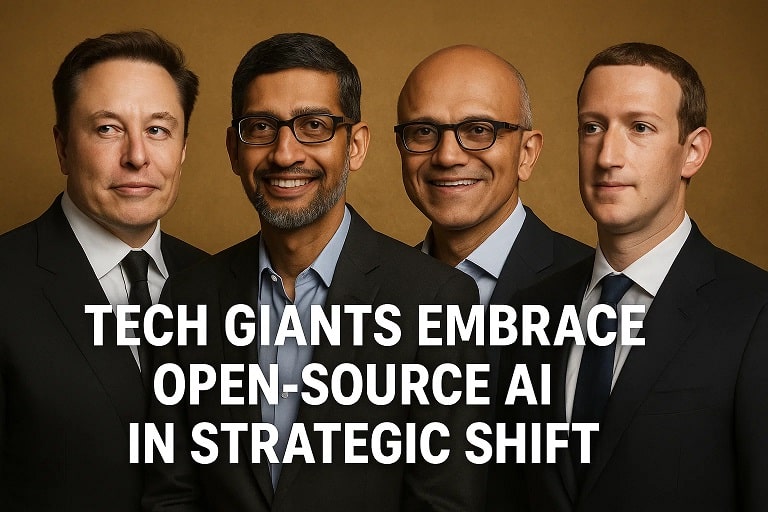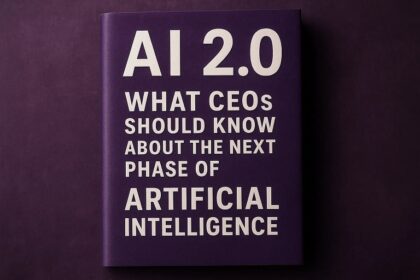Tech Giants Embrace Open-Source AI in Strategic Shift: Redefining Innovation and Competition
By Editorial Desk | August 26, 2025
In a pivotal evolution for the artificial intelligence landscape, tech giants are increasingly embracing open-source AI models, marking a strategic shift toward collaboration, cost efficiency, and rapid innovation. This trend, highlighted by OpenAI’s August 2025 decision to open-source two AI systems and Meta’s ongoing commitment to models like Llama, reflects a departure from proprietary silos to foster interoperability and broader adoption. As AI demands escalate, companies like IBM, Microsoft, and Google are integrating open-source technologies to empower enterprises, reduce barriers, and counter competitive pressures from regions like China. This article delves into the drivers, key players, and implications of this shift, with detailed analysis, tables, and FAQs to provide a comprehensive view of how open-source AI is reshaping the tech industry.
Overview of the Open-Source AI Shift
The year 2025 has seen a surge in open-source AI adoption among tech giants, driven by the need for scalable, customizable solutions amid rising computational costs and regulatory scrutiny. OpenAI’s move to freely share two AI systems with researchers and businesses exemplifies this pivot, aiming to accelerate adoption in emerging markets like India and counter advancements from Chinese firms like DeepSeek. Similarly, Meta’s Llama series continues to lead in open-source LLMs, though recent indications suggest a potential scaling back of full openness. McKinsey’s reports emphasize that large tech players dominate open-source AI tools, with enterprises leveraging them for interoperability and tailored applications. This strategic embrace is projected to unlock significant value, with AI contributing $15.7 trillion to the global economy by 2030, per PwC, and open-source models accelerating enterprise innovation by reducing development barriers.
Detailed Profiles of Key Tech Giants
OpenAI: Pioneering Accessibility
OpenAI’s August 2025 open-sourcing of two AI systems represents a major policy shift, enabling businesses and researchers to build upon its technology freely. This move, aimed at fostering innovation in markets like India, counters China’s open-source momentum, where firms like DeepSeek are spurring rapid adoption. OpenAI’s strategy focuses on ethical AI and global scalability, aligning with broader industry trends.
Meta: Balancing Openness and Control
Meta has built its AI reputation on open-source models like Llama, releasing leading tools to encourage ecosystem growth. However, a July 2025 report suggests Meta may be reconsidering full transparency, potentially retaining advanced features internally to maintain competitive edges. This hybrid approach allows Meta to collaborate while protecting core IP.
IBM and Microsoft: Revitalizing Through Open Source
IBM’s 2025 CEO study advocates adopting open-source AI for interoperability, urging businesses to tailor models to specific needs. Microsoft, embracing open-source as part of its AI strategy, integrates it into Azure to enhance resilience and ownership. These giants are breathing new life into legacy systems by leveraging open-source AI for enterprise transformation.
Google: Championing AI Workloads
Google Cloud’s advancements in handling AI workloads, as evidenced by deals with Meta and OpenAI, emphasize open-source tools for efficiency. The company’s TPUs and Gemini models support open ecosystems, aligning with McKinsey’s findings on tech players dominating open-source AI.
Trends and Implications
Growth Drivers
- Cost and Innovation: Open-source AI reduces development costs by 20–40%, enabling faster iteration and broader access, per Forbes.
- Competitive Response: U.S. firms are pivoting to open-source to counter China’s innovation, where open models boost adoption and challenge Western dominance.
- Enterprise Adoption: Over 70% of enterprises use open-source AI, driven by interoperability and customization, per McKinsey.
- Sustainability: Open-source accelerates open-source software adoption, enhancing resilience and reducing vendor lock-in.
Challenges
- IP Concerns: Companies like Meta may limit openness to protect advancements, risking fragmentation.
- Regulatory Scrutiny: Open-source AI raises ethical issues, with calls for governance in an “Intelligent Age.”
- Talent and Skills: The shift demands reskilling, with 2025 tech jobs redefined by AI integration.
- Geopolitical Risks: China’s open-source embrace challenges U.S. tech, prompting strategic pivots.
Future Projections
By 2030, open-source AI could contribute $15.7 trillion globally, with tech giants leading through hybrid models. Enterprises adopting open-source may see 50% faster innovation, per Forbes, but success hinges on balancing openness with control. In 2025, AI-driven changes in software building will emphasize strategic adoption, per All Things Open. Geopolitical dynamics may accelerate this shift, with open-source as a hedge against disruption.
Key Tech Giants and Open-Source AI Initiatives (2025)
Company | Initiative | Details | Impact |
|---|---|---|---|
OpenAI | Open-Sourcing Two Systems | Freely sharing AI tech for businesses and researchers. | Accelerates adoption in emerging markets like India. |
Meta | Llama Series | Leading open-source LLMs, though openness may evolve. | Builds ecosystem but risks IP protection. |
IBM | Open-Source Advocacy | Recommends for interoperability in CEO study. | Enhances enterprise customization. |
Microsoft | Integration in Azure | Embraces open-source for resilience. | Revitalizes legacy tech with AI. |
Cloud AI Tools | Dominates open-source tools for enterprises. | Handles AI workloads efficiently. |
Projected AI Economic Impact (2025–2030)
Metric | Value | Details | Source |
|---|---|---|---|
Global AI Contribution | $15.7T | By 2030, per PwC. | Economic growth from AI adoption. |
Open-Source Cost Reduction | 20–40% | Development costs, per Forbes. | Enables faster enterprise innovation. |
Productivity Boost | 30%+ | In coding and testing via agentic AI. | Reshapes software development. |
Enterprise Adoption | 70%+ | Using open-source AI tools. | Driven by tech giants. |
Innovation Speed | 50% Faster | For open-source adopters. | Key to competitive edge. |
FAQs
What is the strategic shift toward open-source AI?
Tech giants are increasingly sharing AI technologies freely to foster collaboration, reduce costs, and accelerate innovation, as seen with OpenAI’s recent open-sourcing.
Why are companies like OpenAI pivoting to open-source?
To counter global competition, particularly from China, and enable broader adoption in markets like India, enhancing scalability and ethical AI development.
How does Meta’s approach differ?
Meta has led with open-source models like Llama but may be scaling back full transparency to protect advanced features.
What role do IBM and Microsoft play?
They advocate open-source for interoperability and resilience, integrating it into platforms like Azure to revitalize enterprise tech.
What are the benefits of open-source AI?
Reduced costs (20–40%), faster innovation (50%), and higher productivity (30%+), per industry reports.
What challenges does this shift face?
IP protection, regulatory scrutiny, talent reskilling, and geopolitical risks from competing regions like China.
How does open-source AI impact enterprises?
Over 70% use these tools for customization, with tech giants dominating development.
What is agentic AI’s role?
It enables autonomous decision-making, boosting efficiency in areas like coding and testing.
How does this trend affect global economies?
AI, fueled by open-source, could contribute $15.7 trillion by 2030, reshaping industries.
What’s next for open-source AI?
Increased adoption in 2025, with tech giants balancing openness and control amid geopolitical dynamics.











